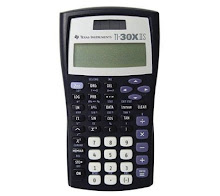Sunday, November 15, 2015
Confidence intervals for standard deviation
Here is a link to a post about estimating sigmax using sx, n and the chi square table. The degrees of freedom will be n - 1.
Thursday, November 12, 2015
Using the Consumer Price Index table
The Consumer Price Index
This week, students got a green handout sheet with the consumer price index number for the years 1950 to 2015. The simplest way to use it goes as follows.
How did prices change from 1960 to 1980? We use the two CPI values.
CPI(1960) = 29.6
CPI(1980) = 82.4
82.4/29.6 = 2.78378.....
29.6/82.4 = .35922...
What these numbers mean is that on average, a $10 item in 1960 sold for 10*2.78378... = $27.84 in 1980, while a $10 item in 1980 would have sold for 10*.35922... = $3.59.
We can use this to figure out the cost of living increase in any given year by dividing the CPI for that year by the CPI for the previous year. For example, the rate in 1975 would be
CPI(1975)/CPI(1974) = 53.8/49.3 = 1.09127789... This is 1 + rate, so rounded to the nearest tenth of a percent we would have 9.1% and to the nearest hundredth of a percent it would be 9.13%.
Let's look at the number CPI(1980)/CPI(1960) = 2.783783... This gives us how much prices increased in the 20 year period from 1961 to 1980. To get the average increase over those 20 years, we take (2.783783)^(1/20) = 1.05252... This is 1 + rate, so the average rate = .05252... or 5.3% if rounded to the nearest tenth of a percent and 5.25% rounded to the nearest hundredth.
This week, students got a green handout sheet with the consumer price index number for the years 1950 to 2015. The simplest way to use it goes as follows.
How did prices change from 1960 to 1980? We use the two CPI values.
CPI(1960) = 29.6
CPI(1980) = 82.4
82.4/29.6 = 2.78378.....
29.6/82.4 = .35922...
What these numbers mean is that on average, a $10 item in 1960 sold for 10*2.78378... = $27.84 in 1980, while a $10 item in 1980 would have sold for 10*.35922... = $3.59.
We can use this to figure out the cost of living increase in any given year by dividing the CPI for that year by the CPI for the previous year. For example, the rate in 1975 would be
CPI(1975)/CPI(1974) = 53.8/49.3 = 1.09127789... This is 1 + rate, so rounded to the nearest tenth of a percent we would have 9.1% and to the nearest hundredth of a percent it would be 9.13%.
Let's look at the number CPI(1980)/CPI(1960) = 2.783783... This gives us how much prices increased in the 20 year period from 1961 to 1980. To get the average increase over those 20 years, we take (2.783783)^(1/20) = 1.05252... This is 1 + rate, so the average rate = .05252... or 5.3% if rounded to the nearest tenth of a percent and 5.25% rounded to the nearest hundredth.
Thursday, November 5, 2015
Answers to Quiz 8
Here are the answers to Quiz 8, which will be counted as a lab instead of a quiz and a new Quiz 8 will be given on Tuesday, with checksums.
Data set: 1990-2009 n = 20
R² =.5956
yp = .1830x - 361.3035
What is the value of yp when you plug in 1990? 2.8665
What is the value of yp when you plug in 2009? 6.3435
95% confidence threshold = .1971 Does R² surpass it? Yes
99% confidence threshold = .3147 Does R² surpass it? Yes
====================
Data set: 1990-2009 n =10
R² =.1601
yp = .1006x -196.0848
What is the value of yp when you plug in 2000? 5.1152
What is the value of yp when you plug in 2009? 6.0206
95% confidence threshold = .3994 Does R² surpass it? No
99% confidence threshold = .5852 Does R² surpass it? No
Tuesday, November 3, 2015
The frequency table solution for TI-83 and TI-84
Put the list of numbers in one list (let's say L1) and the frequencies in a separate list (for simplicity's, make it L2 in this example.) Under the STAT menu, in the CALC sub-menu, choose
2-Var Stats L1, L2
Assuming the frequencies are in the second list, the sum of the y values is n, the size of the sample and the sum of the xy is the sum of all the x values. You then need to divide (sum of xy)/(sum of y) to get the average x-bar.
As for the median, you have to do it by hand, just like the folks with the TI-30xIIs.
Here are the lists from class, the first number x and the second number f(x). The answers are in the comments.
This year's daily differences, 2015 - (avg. 1999-2014)
-9, 1
-8, 3
-7, 4
-6, 7
-5, 13
-4, 15
-3, 12
-2, 16
-1, 11
0, 24
1, 27
2, 24
3, 24
4, 25
5, 18
6, 14
7, 11
8, 8
9, 14
10, 5
11, 7
12, 1
13, 1
14, 4
15, 2
16, 3
17, 5
18, 4
20, 2
21, 1
Here is the list of wins by NFL teams in 2014
12, 5
11, 4
10, 3
9, 4
8, 2
7, 4
6, 3
5, 1
4, 2
3, 2
2, 2
Answers in the comments.
Subscribe to:
Posts (Atom)

